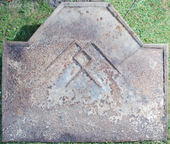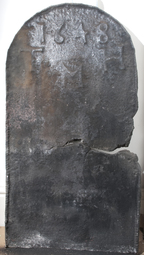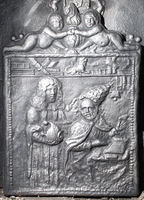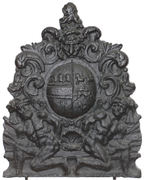-
932
Description: Carved wooden fireback pattern. Canted arched rectangular shape with cavetto-moulded astragal edging; coronet in arch; oval shield with a crowned lion lion rampant, supported two griffons reguardant, the whole within a cartouche, the bottom of which terminates in two swirls between which is a human mask.
Notes: Theodore Agrippa d'Aubigné (1552-1630) was a French poet and writer.
Arms: Theodore Agrippa d'Aubigné
- Decoration tags:
- cavetto arched rectangular (shape)
- astragal with cavetto (edging)
- whole carved pattern
- planklines
- armorial
Manufactured: in the early 17th century in France.
Current location: not known.
Citation: Carpentier, H., 1912, Plaques de Cheminées (Paris & Florange, published by the author).
- Attached to series:
- Patterns
- Personal armorial firebacks
-
247
Description: A modified recasting of a variant of the ‘Armada’ fireback, with initials changed to IK, a single anchor panel, and the addition of a plain base and borders, the latter each with a twisted rope saltire, upper middle.
Notes: It is likely that an original four-panel fireback has been used to recast a copy with additional side and base panels; the saltires may have apotropaic significance. A second fireback at the house cast in the 19th century is identical but for being 1% smaller all round, and has a full-width extension on top bearing four symmetrical rope saltires, the outer two larger than the inner two. The first example was used to make the second.
Inscription: 1588 / IK
- Decoration tags:
- arched rectangular (shape)
- simulated rope (edging)
- simple stamps
- carved pattern panels
- composite
- extension panels
- apotropaic
- text
- plants
- objects
Manufactured: in the 17th century in the Weald area of England.
Current location: Chawton House, Chawton, Hampshire, England.
- Attached to series:
- Armada series
-
465
Description: Rectangular with three-faced arch; ogee moulded edging; top centre, overlapping, crossed staples arranged diagonally, each pointing to a bottom corner.
Notes: The crossed staple is the badge of the Nevill family, and this fireback came from Eridge Park, the seat of the Marquess of Abergavenny.
- Decoration tags:
- rectangle with three-facetted arch (shape)
- cyma reversa/ogee (edging)
- simple stamps
- heraldic
- objects
Manufactured: in the 18th century possibly in the Weald area of England.
Current location: in private hands, Little Horsted, East Sussex, England.
- Attached to series:
- Personal firebacks
- Metalware stamp firebacks
-
1073
Description: Arched; twisted rope edging; date at top; initials in triad below date.
Notes: An unusually tall fireback in proportion to its height, probably specifically related to its early use with a coal fire.
Inscription: 1648 / TMH [triad]
- Decoration tags:
- arched (shape)
- rope (edging)
- carved stamps
- individual letters
- individual numbers
- text
Manufactured: in 1648 possibly at Tintern Furnace in the Forest of Dean area of Wales.
Current location: in private hands, Mathern, Monmouthshire, Wales.
- Attached to series:
- 1640-50s Dean series
-
609
Description: Rectangular with plait-effect border and a column of beads down each side; pictorial scene of a male figure in gown and full-bottom wig, holding a fool’s cap in his right hand, standing behind a seated male figure, bald and bearded, with the papal triple crown falling off his head; he is seated at a desk on which are two books; behind him and to the right, three books are on a small shelf. Above the figures, a longer shelf, the width of the plate, supports other books and papers, together with the figure of a dog, from whose mouth a scroll issues bearing an unreadable inscription. On top, two putti hold hands in front of a flaming grenade.
Notes: The design is copied from a cartoon of c.1672 showing Titus Oates, the instigator of the popish Plot, presenting a fool’s cap to the Pope (see Hodgkinson 2010, p.209).
Copies of this fireback are known.
- Decoration tags:
- quasi-arched rectangular (shape)
- bead (edging)
- whole carved pattern
- pictorial
- humans
- objects
Manufactured: in the late 17th century in England.
Current location: Mark Ripley Forge & Fireplaces, Northbridge Street, Robertsbridge, East Sussex, England.
- Attached to series:
- Miscellaneous pattern firebacks
-
757
Description: Oval armorial bearings carried by two naked, kneeling male figures, between them a scallop shell; above the shield a lion’s face surmounted by a crest of a lion’s head erased; the shield is surrounded by floral scrolls. The arms are of Worge impaling Collier: Worge - gules, a fess ermine, cotised argent, in chief three lion’s heads erased of the last; Collier - argent, on a chevron azure, between three unicorns courant couped gules, as many oak sprigs fructed proper.
Notes: George Worge (1705-65), of Starr’s Green, Battle, steward of the Battle Abbey estate, married Elizabeth Collier (d.1767) of Hastings in 1729. This deeply detailed fireback might have been cast in a closed mould; it had a circular aperture in the centre into which, in this instance, an armorial was placed; the same armorial is on a fireback, dated 1762, at Great Dixter, Northiam, Sussex.
Arms: Worge impaling Collier (George Worge)
- Decoration tags:
- baroque (shape)
- complex individual (edging)
- whole carved pattern
- pictorial
- armorial
- humans
Manufactured: in the early to mid 18th century possibly at Robertsbridge Furnace, Salehurst in the Weald area of England.
Current location: Victoria & Albert Museum, Cromwell Road, Kensington & Chelsea, Greater London, England.
Museum number: 686.1899 (part of the Victoria & Albert Museum museum group)
- Attached to series:
- Baroque series
- Personal armorial firebacks
 carpentier p229 690x870.png)




